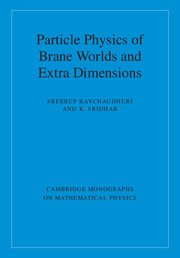Book contents
- Frontmatter
- Dedication
- Contents
- Preface
- 1 Dimensional dreams
- 2 The Standard Model and beyond
- 3 The birth of compact dimensions
- 4 String theory: a review
- 5 Effective theories
- 6 Large extra dimensions
- 7 Visible towers of invisible gravitons
- 8 Making black holes
- 9 Universal extra dimensions
- 10 Warped compactifications
- 11 Graviton resonances
- 12 Stability of warped worlds
- 13 Exploring the bulk
- 14 Epilogue
- Appendix A General Relativity in a nutshell
- Appendix B Testing the inverse-square law
- References
- Index
Preface
Published online by Cambridge University Press: 05 July 2016
- Frontmatter
- Dedication
- Contents
- Preface
- 1 Dimensional dreams
- 2 The Standard Model and beyond
- 3 The birth of compact dimensions
- 4 String theory: a review
- 5 Effective theories
- 6 Large extra dimensions
- 7 Visible towers of invisible gravitons
- 8 Making black holes
- 9 Universal extra dimensions
- 10 Warped compactifications
- 11 Graviton resonances
- 12 Stability of warped worlds
- 13 Exploring the bulk
- 14 Epilogue
- Appendix A General Relativity in a nutshell
- Appendix B Testing the inverse-square law
- References
- Index
Summary
The gods love what is mysterious, and dislike what is evident.
Brihadaranyaka Upanishad IV.2.2For 49 out of the 50 centuries of recorded history, the idea of extra dimensions of space was the province of the mystic, the crank and the trickster. For what could be more obvious than the fact that there are three dimensions – length, breadth and height – as every schoolchild knows? Take a brick, for example, which is so reassuringly solid, and seems so uncompromisingly three-dimensional. Yet, for the last century or so, modern atomic science has been telling us that the solid brick is 99.99999999999% empty space. What remains is some little bits of matter, flying around eternally, and held together by electromagnetic pulls and pushes of incredible strength. This may seem bizarre and unreal, but that's how it is.
We have learnt, therefore, that ‘common sense’ – or rather, the evidence of our five senses – is not a trustworthy guide to the world when we try to perceive it at length scales much below the size of an average human. Once we are trained to have an open mind in his way, there is no problem at all in conceiving of more dimensions of space – they just have to be curled up into tiny loops, or spheres or higher dimensional compact objects. If the size of these is below the resolution of the human eye (or any instruments which aid the human eye), these extra dimensions will be invisible, just as atoms and molecules were at the time they were conceived of.
Most scientists encounter curled-up dimensions without realising it, when they study the quantum physics of solids. There, one can set up a wave function of an electron in a solid by invoking a ‘periodic boundary condition’, which is another way of saying that the co-ordinates are curled up. In fact, a three-dimensional solid is actually treated in the textbooks as a 3-torus, which is a complicated topological object that cannot be drawn on paper. If we can get useful and experimentally verifiable results by assuming a block of copper, for example, to be a 3-torus, surely it is not too much of a flight of fancy to assume that the selfsame block also has other dimensions, similarly curled-up, which are too small to be seen?
- Type
- Chapter
- Information
- Particle Physics of Brane Worlds and Extra Dimensions , pp. xiii - xviPublisher: Cambridge University PressPrint publication year: 2016



